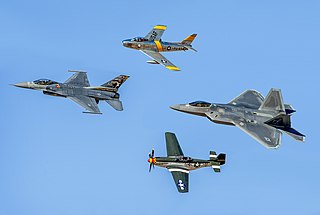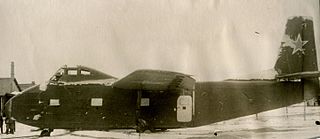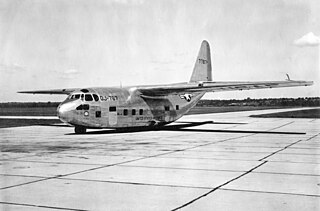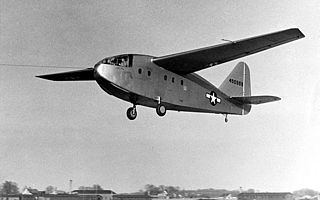
A military aircraft is any fixed-wing or rotary-wing aircraft that is operated by a legal or insurrectionary military of any type. Military aircraft can be either combat or non-combat:

Fairchild was an American aircraft and aerospace manufacturing company based at various times in Farmingdale, New York; Hagerstown, Maryland; and San Antonio, Texas.

The Fairchild C-123 Provider is an American military transport aircraft designed by Chase Aircraft and then built by Fairchild Aircraft for the U.S. Air Force. In addition to its USAF service, which included later service with the Air Force Reserve and the Air National Guard, it also went on to serve most notably with the U.S. Coast Guard and various air forces in Southeast Asia. During the War in Vietnam, the C-123 was used to deliver supplies, to evacuate the wounded, for agent insertions behind enemy lines, and was also used to spray Agent Orange.

The Chase Aircraft Company, founded in 1943, was an American aircraft manufacturer, primarily constructing assault gliders and military transport aircraft. Lacking space for expansion, the company was purchased by Henry J. Kaiser in 1951. Plans to produce the C-123 transport for the United States Air Force collapsed amid scandal, and the company closed in 1953. A successor company, Stroukoff Aircraft, continued experimental work for several years before closing in 1959.

Military gliders have been used by the militaries of various countries for carrying troops and heavy equipment to a combat zone, mainly during the Second World War. These engineless aircraft were towed into the air and most of the way to their target by military transport planes, e.g., C-47 Skytrain or Dakota, or bombers relegated to secondary activities, e.g., Short Stirling. Most military gliders do not soar, although there were attempts to build military sailplanes as well, such as the DFS 228.

The Stroukoff YC-134, designed in 1956, was based heavily on the Fairchild C-123 Provider, itself designed by Michael Stroukoff. The United States military contracted with Stroukoff Aircraft Corporation to develop an improved version of the aircraft, combining features that the company had developed for the YC-123D and YC-123E.

Denton Enterprise Airport, also known as Denton Airport and previously Denton Municipal Airport, is a city-owned, public-use airport located three nautical miles (6 km) west of the central business district of Denton, a city in Denton County, Texas, United States.

The Yakovlev Yak-14 was the largest assault glider ever to enter service with the Soviet Air Force. It was introduced in 1949, at a time when other air forces were abandoning the glider concept. In 1950 a Yak-14 became the first glider to fly over the North Pole.

The Waco CG-4 was the most widely used American troop/cargo military glider of World War II. It was designated the CG-4A by the United States Army Air Forces, and given the service name Hadrian by the British.

The Fokker F-32 was a passenger aircraft built by the Fokker Aircraft Corporation of America in 1929 in their Teterboro, New Jersey factory. It was the first four-engined aircraft designed and built in the United States. Ten examples were built, but they only entered limited commercial service; their high cost and problems with the cooling of the aft engines proved prohibitive. The United States Army Air Corps evaluated the F-32 as the YC-20, but did not purchase it.

The Chase XCG-18A and YC-122 Avitruc was a military transport aircraft designed by Chase Aircraft and produced in limited numbers in the United States in the late 1940s, initially as a glider, but definitively in powered form. The design was based on the CG-14 cargo glider but was substantially larger and featured all-metal construction. It was a high-wing cantilever monoplane. The fuselage was of rectangular cross-section and featured a loading ramp at its rear. The main undercarriage units were carried at the sides of the fuselage and were fixed, while the nosewheel was retractable. In its powered form, two radial engines were fitted in nacelles in the wings.

The Chase XCG-20, also known as the XG-20 and by the company designation MS-8 Avitruc, was a large assault glider developed immediately after World War II by the Chase Aircraft Company for the United States Air Force, and was the largest glider ever built in the United States. The XG-20 did not see production due to a change in USAF requirements, however, it was modified into the successful Fairchild C-123 Provider twin-engined transport aircraft which saw extensive service in the Vietnam War.

The Douglas XCG-17 was an American assault glider, developed by the conversion of a C-47 Skytrain twin-engine transport during World War II. Although the XCG-17 was successfully tested, the requirement for such a large glider had passed, and no further examples of the type were built; one additional C-47, however, was converted in the field to glider configuration briefly during 1946 for evaluation, but was quickly reconverted to powered configuration.
Richard H. Johnson was a glider pilot, aeronautical engineer and prolific writer of articles for gliding magazines. He was an 11-time U.S. National Champion glider pilot, 9-time US Soaring Team pilot at the Soaring World Championships, held two World Gliding Records and is a member of the US Soaring Hall of Fame. He flew for 70 years and logged over 14,000 flying hours, including over 10,000 hours of non-powered flight time in sailplanes. He authored over 100 articles on soaring and flight tests of gliders.

The 75th Troop Carrier Squadron is an inactive United States Air Force unit. It was last assigned to the 316th Troop Carrier Group at Ashiya Air Base, Japan, where it was inactivated on 18 June 1957.

The Chase XC-123A was an experimental transport aircraft developed by Chase Aircraft. The first jet-powered transport built for the United States Air Force, it was intended for use as a high-speed transport for high-priority cargo and personnel. The XC-123A was determined to have insufficient advantages over existing types in service, and did not go into production. The sole prototype was converted into the piston-powered Stroukoff YC-123D to evaluate boundary layer control systems.

The Chase CG-14, also known as the G-14 or Model MS.1, was an assault glider manufactured by Chase Aircraft for the United States Army Air Forces during the Second World War. The aircraft failed to progress beyond the prototype stage, being overtaken by larger, improved glider designs.
Stroukoff Aircraft was an American manufacturer of experimental military transport aircraft, established in 1954 by Michael Stroukoff. Successor to Chase Aircraft, the company specialised in developing advanced variants of the C-123 Provider; however, none of the company's designs attracted a production order, and the company folded in 1959.
The Cornelius XBG-3 was an American "bomb glider", developed by the Cornelius Aircraft Corporation for the United States Army Air Forces. Using an unconventional design that included a forward-swept wing, a single prototype was ordered in 1942; however the contract was cancelled later that year before the aircraft had been constructed.
















